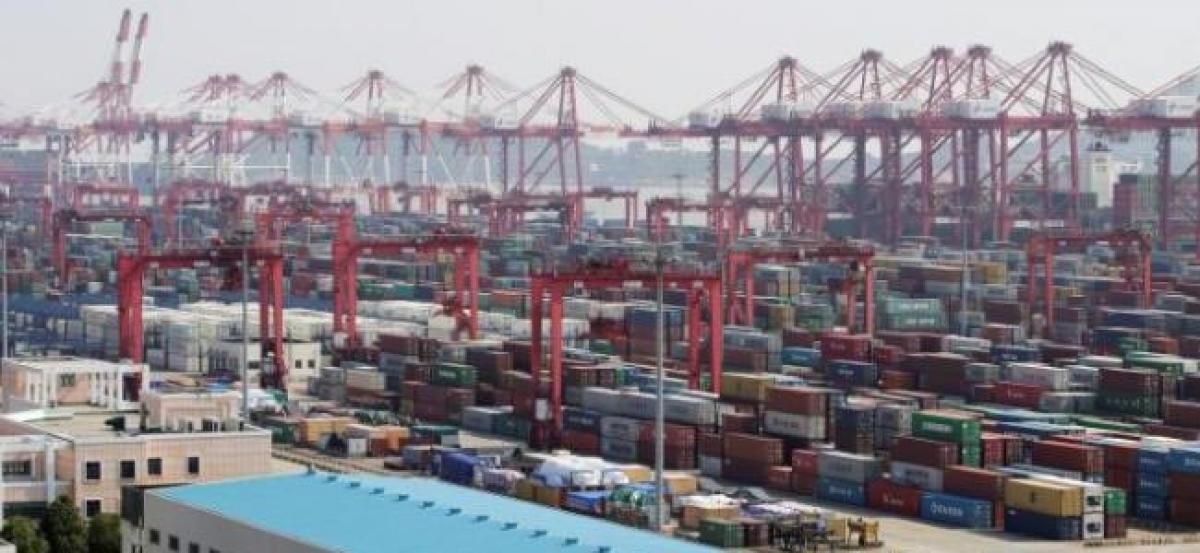Live
- PM Modi highlights govt's efforts to make Odisha prosperous and one of the fastest-growing states
- Hezbollah fires 200 rockets at northern, central Israel, injuring eight
- Allu Arjun's Family Appearance on Unstoppable with NBK Breaks Viewership Records
- Unity of hearts & minds essential for peace & progress, says J&K Lt Governor
- IPL 2025 Auction: I deserve Rs 18 cr price, says Chahal on being acquired by Punjab Kings
- EAM Jaishankar inaugurates new premises of Indian embassy in Rome
- Sailing vessel INSV Tarini embarks on second leg of expedition to New Zealand
- Over 15,000 people affected by rain-related disasters in Sri Lanka
- IPL 2025 Auction: RCB acquire Hazlewood for Rs 12.50 cr; Gujarat Titans bag Prasidh Krishna at Rs 9.5 crore
- Maharashtra result reflects the outcome of Congress' destructive politics: BJP's Shazia Ilmi
Just In

China\'s September exports fell 10 percent from a year earlier, far worse than expected, while imports unexpectedly shrank after picking up in August, suggesting signs of steadying in the world\'s second-largest economy may be short-lived.
Beijing: China's September exports fell 10 percent from a year earlier, far worse than expected, while imports unexpectedly shrank after picking up in August, suggesting signs of steadying in the world's second-largest economy may be short-lived.
The disappointing trade figures pointed to weaker demand both at home and aboard, and deepened concerns over the latest depreciation in China's yuan currency, which hit a fresh six-year low against a firming U.S. dollar on Thursday.
"This comes on the heels of weak South Korean trade data, and it definitely make us worry about to what extent global demand is improving," said Luis Kujis, head of Asia economics at Oxford Economics in Hong Kong.
Asian stocks tumbled to three-week lows and U.S. stock futures and Treasury yields fell after the data, while copper prices in London slipped.
China's exports had been expected to fall 3 percent, slightly worse than in August as global demand for Asian goods remains stubbornly weak despite heading into what is usually the peak year-end shopping season.
Weaker demand for Chinese goods was seen in nearly all of its major markets in the U.S., Europe and much of Asia.
Imports shrank 1.9 percent, dashing hopes for a second rise in a row. Imports had unexpectedly grown 1.5 percent in August, the first expansion in nearly two years, on stronger demand for coal and commodities such as iron ore which are feeding a construction boom.
That left China with a trade surplus of $41.99 billion for the month, the lowest in six months, the General Administration of Customs said on Thursday. Analysts had expected it to expand slightly to $53 billion.
The weaker trade readings could raise concerns about the other September data and third-quarter GDP over the coming week. Economists had expected that data to show the economy was stabilising and perhaps even slowly picking up.
The import reversal raises questions over the strength of the recent recovery in domestic demand, Julian Evans-Pritchard at Capital Economics said in a note.
"This could be an early sign that the recent recovery in economic activity is losing momentum, although we would caution against reading too much into a single data point given the volatility of the trade figures," he said.
"The continued underwhelming performance of Chinese exports adds weight to our view that the People’s Bank will maintain its recent policy of gradual trade-weighted renminbi (yuan) depreciation in coming quarters," he added.
Last month, the World Trade Organization cut its forecast for global trade growth this year by more than a third to 1.7 percent, reflecting a slowdown in China and falling levels of imports into the United States.
DOUBTS ABOUT RECOVERY
To be sure, China's imports of crude oil rose 18 percent on-year to a daily record, while iron ore purchases surged to the second highest on record, suggesting its demand for global commodities is hardly falling off a cliff.
Steel mills, in particular, appear to be running hot to meet demand from a housing boom and government infrastructure projects, which are driving higher profits.
But copper, coal and soybean imports all fell from August.
"China imported too much copper in the beginning of this year," said Chris Wu, an analyst at CRU Beijing, a metals consulting firm. "The lagging effect from the property market is still helping with some of the end use sectors for example wire and cables and white goods, but we are afraid the boom is close to the end."
A Customs spokesperson said on Thursday rising imports of oil and other commodities showed demand is improving, adding that the government's trade policies is having positive effects.
After a rough start to the year, China's economy has shown signs of steadying thanks largely to the building boom, but some analysts warn the housing frenzy may be peaking as more cities impose restrictions on home buying to keep prices from overheating.
Data have also highlighted growing imbalances in China's economy, with growth increasingly reliant on government spending as private investment falls to record lows. Larger state firms are expanding, likely thanks to Beijing's largesse, but smaller manufacturers continue to struggle.

© 2024 Hyderabad Media House Limited/The Hans India. All rights reserved. Powered by hocalwire.com







